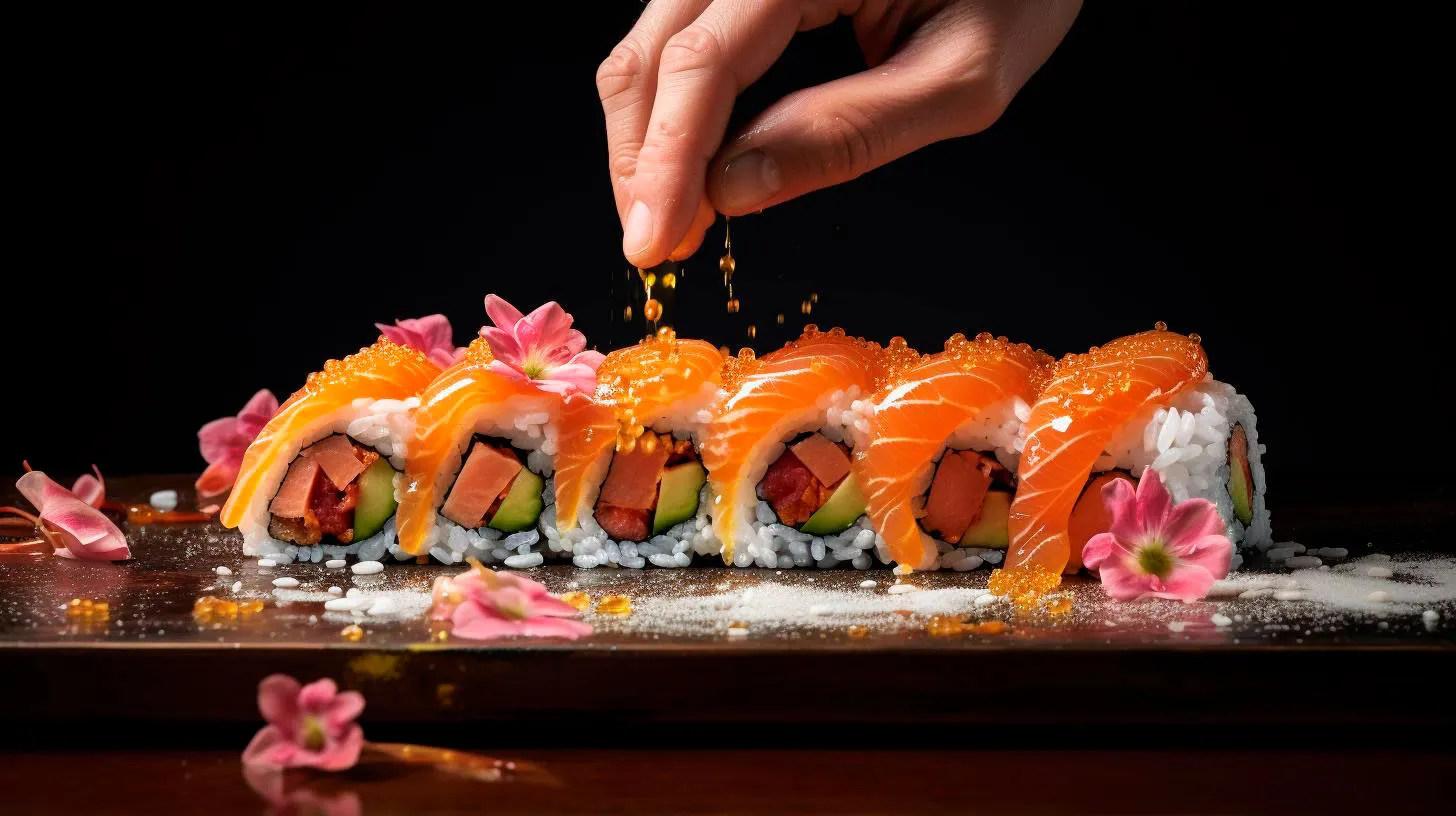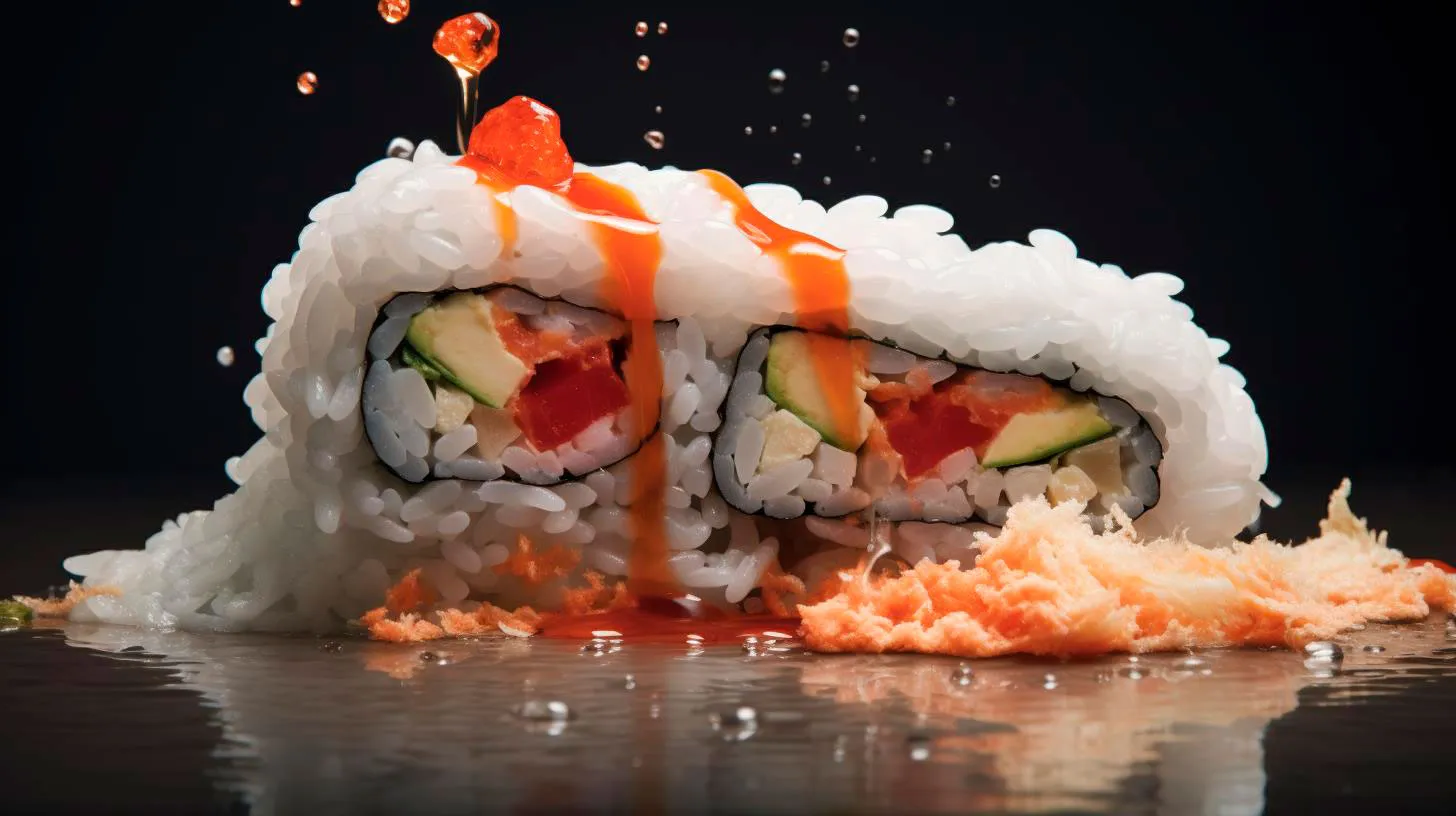Savoring Sushi: Exploring the Palate and Flavors of Japan through its Famous Cuisine
With its delicate flavors and artistic presentation, sushi has captivated the taste buds of people around the globe. In this article, we will take a deep dive into the world of sushi, exploring its history, flavors, and the artistry behind it.
The Origins of Sushi
Sushi, in its earliest form, dates back over 2000 years ago in Southeast Asia. Originally, it was a method of preserving fish by fermenting it with rice and salt. Over time, this technique evolved into what we now know as sushi, where raw fish and other ingredients are combined with vinegared rice and served as bite-sized pieces.
It wasn’t until the 19th century that sushi gained popularity beyond Japan’s borders. With the opening of Japan to foreign trade, sushi restaurants began to emerge in other parts of the world. Today, sushi has become an international sensation, loved by people from all walks of life.
The Artistry of Sushi
One of the defining characteristics of sushi is its meticulous presentation. Sushi chefs, known as Itamae, undergo years of training to master the art of sushi-making. Each piece of sushi is created with precision, reflecting the chef’s skill and attention to detail. From the way the fish is sliced to the placement of garnishes, every aspect is carefully considered.
Sushi is often compared to a piece of art. The balance of colors, textures, and flavors contributes to the overall aesthetic appeal. It is not uncommon to see sushi served on beautiful ceramic plates or lacquered wooden trays, enhancing the dining experience even further.
The Flavors of Sushi
One of the reasons sushi has become a culinary sensation is its diverse range of flavors. While raw fish is a popular choice, sushi also includes vegetarian options and cooked ingredients. The combination of vinegared rice with various toppings and fillings creates a unique explosion of tastes in every bite.
Here are some key flavors and ingredients you can savor in sushi:
- Wasabi: A green paste made from Japanese horseradish that adds a spicy kick to sushi.
- Soy Sauce: A savory and salty condiment that complements the flavors of sushi.
- Ginger: Pickled ginger, often served as a palate cleanser between sushi pieces.
- Tuna: A popular fish choice for sushi, known for its rich flavor and smooth texture.
- Salmon: Another beloved fish, prized for its buttery taste and vibrant color.
- Avocado: A creamy and refreshing ingredient often used in vegetarian sushi rolls.
These are just a few examples of the myriad flavors you can uncover while exploring sushi.
The Health Benefits of Sushi
Aside from its unique flavors and artistry, sushi also offers several health benefits. Here are some key takeaways:
- Omega-3 Fatty Acids: Many types of fish used in sushi, such as salmon and tuna, are rich in omega-3 fatty acids, which have been linked to numerous health benefits, including heart health and cognitive function.
- Lean Protein: Sushi is a great source of lean protein, making it an excellent choice for those looking to maintain a balanced diet.
- Low in Calories: Sushi rolls typically contain fewer calories compared to other fast food options, making it a healthier alternative.
- Rich in Antioxidants: Ingredients like seaweed and ginger offer valuable antioxidants that may help boost the immune system and support overall well-being.
These health benefits add to the appeal of sushi, making it a popular choice for health-conscious individuals.
Conclusion
Sushi is more than just a culinary delight; it is a symbol of Japan’s rich cultural heritage and artistic expression. Its flavors, presentation, and health benefits make it an enticing option for food lovers worldwide. So next time you savor a piece of sushi, take a moment to appreciate the artistry that goes into creating this extraordinary dish.
Remember, sushi is not just a meal but an experience that allows you to explore the palates and flavors of Japan, one bite at a time.
Jiro Dreams of Sushi: A Documentary Exploration of Passion, Perfection, and the Human Spirit
As we delve into Jiro’s story, we are left inspired by his unwavering commitment to his craft, his pursuit of perfection, and the extraordinary dedication he and his team put into every single piece of sushi they create.
Let’s dive deeper into this documentary exploration and uncover the key takeaways, advantages, and features that make “Jiro Dreams of Sushi” a must-watch for any food lover, entrepreneur, or artist:
The Power of Passion and Perseverance
Jiro Ono’s lifelong dedication to the art of sushi-making is a testament to the transformative power of passion. With relentless pursuit, he has honed his skills over decades, never settling for anything less than perfection. His unwavering commitment to his craft serves as a reminder that success comes to those who are willing to invest time, effort, and true passion into their work.
- Key Takeaway: Passion is the driving force behind extraordinary achievements. Find what you love and dedicate yourself wholeheartedly to it.
Seeking Perfection in Every Detail
In Jiro’s world, every detail matters. From the sourcing of ingredients to the meticulous preparation, each step is executed with precision and purpose. “Jiro Dreams of Sushi” brilliantly showcases the pursuit of perfection in every single piece of sushi created at Sukiyabashi Jiro. This dedication to excellence is a reminder that greatness lies in the details, and constant improvement is the path to mastery.
- Key Takeaway: Strive for excellence in every aspect of your work, no matter how small. Attention to detail sets apart the extraordinary from the ordinary.
The Importance of Tradition and Craftsmanship
Jiro Ono embodies the rich traditions of Japanese cuisine and the art of sushi-making. Throughout the documentary, we witness the passing down of knowledge from generation to generation, emphasizing the importance of preserving heritage and craftsmanship. This respect for tradition and commitment to quality are foundational elements that have established Sukiyabashi Jiro as an institution in the culinary world.
- Key Takeaway: Embrace and honor the traditions that have shaped your craft. Recognize the value of learning from those who came before you.
The Human Spirit and Success
“Jiro Dreams of Sushi” goes beyond showcasing Jiro’s culinary expertise. It explores his personal journey, his sacrifices, and his unwavering dedication to his craft. By delving into the intimate aspects of his life, the film reveals the complex relationship between success, passion, and the human spirit. Jiro’s story teaches us that true success requires a balance between personal fulfillment, professional achievement, and the relationships we foster along the way.
- Key Takeaway: Success is not solely defined by career achievements, but by personal growth, satisfaction, and the connections we forge with others.
Facts and Figures:
- Sukiyabashi Jiro holds three Michelin stars, making it one of the most prestigious sushi restaurants in the world.
- The documentary received critical acclaim, scoring an impressive 99% rating on Rotten Tomatoes.
- Jiro Dreams of Sushi was also nominated for the Grand Jury Prize at the 2011 Sundance Film Festival.
- The film showcases the meticulous process behind the making of sushi, highlighting the years of training and dedication required to become a sushi master.
- Sukiyabashi Jiro only accommodates a limited number of customers, allowing for an intimate dining experience.
In conclusion, “Jiro Dreams of Sushi” is a thought-provoking documentary that explores the depths of passion, the relentless pursuit of perfection, and the unwavering human spirit. It serves as a powerful reminder that greatness is achieved through dedication, attention to detail, and honoring tradition. Whether you are a food lover, artist, or entrepreneur, this documentary will ignite a fire within you to pursue your passions with unwavering commitment.
Sushi Secrets Revealed: Unveiling the History and Traditions Behind this Iconic Japanese Dish
The Origins of Sushi
Sushi, a traditional Japanese cuisine, dates back to the 8th century. Originally, sushi referred to the fermentation process used to preserve fish by combining it with rice and salt. During these early times, sushi was consumed only after the fermentation was complete, discarding the rice.
Over time, as the preservation techniques improved, individuals discovered that the rice could be eaten along with the fish, resulting in the birth of Nare-zushi. This type of sushi was typically consumed after a lengthy duration of fermentation, resulting in a very pungent flavor.
As sushi became more popular, particularly during the Edo period (1603-1868), techniques such as Nigiri-zushi started to emerge. This new style involved molding vinegared rice together with fresh fish, creating the sushi we are most familiar with today. The Edo period marked the transition of sushi from a preservation technique to a delectable delicacy.
The Artistry of Sushi
Sushi is not just about the taste but also about the artistry that goes into its creation. Each sushi chef, known as itamae, possesses years of training and expertise to perfect their craft. Here are some key features and advantages that make sushi stand out:
- Quality Ingredients: Sushi relies heavily on fresh, high-quality ingredients. The use of seasonal fish and seafood ensures a rich and flavorful experience.
- Presentation: Sushi is known for its beautiful presentation, which often resembles a work of art. The vibrant colors and meticulous arrangement of each piece indicate the chef’s attention to detail and skill.
- Taste and Texture: The combination of tender fish, perfectly seasoned rice, and a variety of textures create a harmonious balance of flavors in every bite.
The Significance of Sushi in Japanese Culture
Sushi holds a prominent place in Japanese culture, going beyond its culinary significance. Here are some key takeaways regarding the cultural significance of this iconic dish:
- Symbol of Celebration: Sushi has long been associated with celebrations and special occasions in Japan. It is often served during festivals, weddings, and other joyous events.
- Community and Sharing: The act of sharing sushi brings people together, fostering a sense of community and camaraderie. In traditional sushi restaurants, customers sit around the sushi counter, engaging in conversations with the itamae.
- Attention to Detail: Japanese culture places a strong emphasis on precision and attention to detail, traits that are reflected in the art of sushi-making. The meticulousness and craftsmanship required to create sushi mirrors these cultural values.
Health Benefits of Sushi
Sushi not only delights our taste buds but also offers several health benefits. Here are some key advantages of incorporating sushi into your diet:
- Omega-3 Fatty Acids: Fish used in sushi, such as salmon and tuna, are rich in omega-3 fatty acids, which promote heart health and reduce the risk of cardiovascular diseases.
- Low in Calories: Sushi can be a healthier alternative for those looking to maintain a balanced diet. Rolls with fresh vegetables and lean proteins can be low in calories while providing essential nutrients.
- Rich in Antioxidants: A variety of sushi ingredients, such as seaweed and pickled vegetables, contain antioxidants that help boost the immune system and promote overall well-being.
In conclusion, sushi offers much more than just a delectable dining experience. Its rich history, cultural significance, and health benefits make it an iconic dish cherished by people worldwide. Next time you indulge in the art of sushi, take a moment to appreciate the centuries of tradition and the craftsmanship that goes into creating this culinary masterpiece.
The Art of Sushi: A Culinary Journey Through Japanese Culture
The Origins of Sushi
Sushi originated in Japan around the 8th century as a method of preserving fish. The fish would be fermented with rice, and after a few months, the rice was discarded, and the fish was consumed. This early form of sushi was vastly different from the sushi we know today. It wasn’t until the 19th century, during the Edo period, that sushi evolved into the bite-sized delicacy we are familiar with.
Initially, sushi was sold in street food stalls and served as a quick meal for busy on-the-go individuals. However, over time, it gained popularity among the higher social classes and became associated with elegance and refinement. Fast forward to the present day, sushi is enjoyed by people from all walks of life and has become a global phenomenon.
The Art of Sushi Making
Creating sushi requires precision, skill, and an understanding of the delicate balance of flavors. Here are some key techniques and elements involved in the art of sushi making:
- Nigiri: Nigiri sushi consists of a small mound of rice topped with a slice of raw fish or seafood. The rice should be firmly pressed and shaped by hand to ensure it holds together when picked up with chopsticks.
- Maki: Maki sushi, commonly known as rolled sushi, is made by tightly wrapping a sheet of nori seaweed around a filling of rice, fish, vegetables, or other ingredients. The roll is then sliced into bite-sized pieces.
- Sashimi: Although not technically sushi, sashimi is often served alongside sushi and is a must-try for seafood lovers. It consists of thinly sliced raw fish or seafood, skillfully cut into bite-sized pieces.
The Significance of Sushi in Japanese Culture
In Japan, sushi is not just a meal—it is a symbol of tradition, craftsmanship, and respect for the ingredients. Here are a few reasons why sushi holds such significance in Japanese culture:
- Seasonality: Traditional sushi chefs pay great attention to the seasons when choosing their ingredients. They believe that the taste and quality of the fish vary throughout the year, ensuring that the sushi served reflects the freshest and best flavors of each season.
- Presentation: The visual appeal of sushi is as important as its taste. Sushi chefs meticulously arrange the ingredients to create visually stunning pieces of artwork. The colors, textures, and shapes of the sushi reflect the harmony between nature and food, a concept deeply rooted in Japanese aesthetics.
- Omakase: Omakase, meaning “I leave it up to you,” is a dining experience where customers entrust the chef to create a personalized menu based on their preferences. This allows the chef to showcase their skills and creativity, providing guests with a unique and unforgettable sushi experience.
Key Takeaways
Sushi is not just a dish; it is a masterpiece that embodies the essence of Japanese culture. Here are some key takeaways from our culinary journey through the art of sushi:
- Sushi originated in Japan as a method of preserving fish, but has evolved into a globally celebrated delicacy.
- The art of sushi making involves techniques such as nigiri, maki, and sashimi, showcasing the skill and precision of chefs.
- Sushi represents seasonality, aesthetics, and the concept of omakase, making it a unique cultural experience.
So, the next time you indulge in a plate of sushi, take a moment to appreciate the culinary craftsmanship and the centuries-old traditions it carries. Immerse yourself in the art of sushi, and let your taste buds embark on a journey through Japanese culture.


